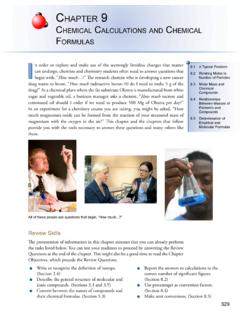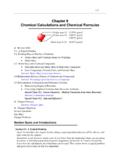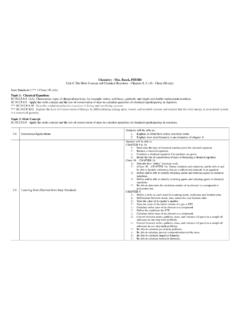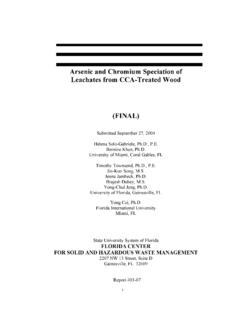Transcription of Chapter 10 Chemical Bonding - Millersburg Area School ...
1 Chapter 10 Chemical Bonding 2 Bonding Theories Bonding -- the way atoms attach to make molecules. Bonding can help us: the shapes of molecules and their properties as well. and build molecules with particular sets of Chemical and physical properties. 3 Lewis Theory Uses dots to represent valence electrons. Arranges Bonding between atoms to attain certain sets of stable valence electron arrangements. 4 Lewis Theory Lewis theory emphasizes the importance of valence electrons. Uses symbol of element to represent nucleus and inner core electrons. Uses dots around the symbol to represent valence electrons. Li Be B C N O: :F: :Ne: 5 Example Write the Lewis Symbol for Arsenic, As is in column 5A, therefore it has 5 valence electrons. As6 Lewis Bonding Theory Atoms bond because it results in a more stable electron configuration.
2 Atoms bond together by either transferring or sharing electrons. Usually this results in all atoms obtaining an outer shell with 8 electrons. Octet rule. some exceptions to this rule Li and Be Ionic Bonds Bonds formed between metals and nonmetals Recall metals lose electrons--- Cations Nonmetals gain electrons--- Anions Therefore electrons must be transferred from atom to another for Bonding to occur 7 8 Example Using Lewis Theory to Predict Chemical Formulas of Ionic Compounds Predict the formula of the compound that forms between calcium and chlorine. Draw the Lewis dot symbols of the elements. Ca Cl Transfer all the valence electrons from the metal to the nonmetal. Ca Cl Cl Ca2+ ::Cl ::ClCaCl2 9 Covalent Bonds Bond form between two nonmetals. The type of compound formed are known as molecular or covalent compounds Atoms share pairs of electrons to attain octets.
3 Types covalent bonds Single Double Triple 10 Single Covalent Bonds Two atoms share one pair of electrons. F F H F F H O H H O F F 11 Double Covalent Bond Two atoms sharing two pairs of electrons. 4 electrons. Shorter and stronger than single bond. O O O O O O 12 Triple Covalent Bond Two atoms sharing 3 pairs of electrons. 6 electrons. Shorter and stronger than single or double bond. N N N N N N Trends in Bond Length and Energy Bond Length (pm) Energy (kJ/mol) C-C 154 346 C=C 134 602 C C 120 835 C-N 147 305 C=N 128 615 C N 116 887 C-O 143 358 C=O 123 799 14 Bonding and Lone Pair Electrons Bonding pairs--Electrons that are shared by atoms Lone pairs-- Electrons that are not shared by atoms but belong to a particular atom Also known as nonbonding pairs. O S O Lone pairs Bonding pairs 15 Lewis Structures of Molecules Some common Bonding patterns.
4 C = 4 bonds & 0 lone pairs. 4 bonds = 4 single, or 2 double, or single + triple, or 2 single + double. N = 3 bonds & 1 lone pair. O = 2 bonds & 2 lone pairs. H and halogen = 1 bond. Be = 2 bonds & 0 lone pairs. B = 3 bonds & 0 lone pairs. B C N O F 16 Writing Lewis Structures for Covalent Molecules Example: Write the Lewis Structure of CO2 17 Write skeletal structure. Most metallic atom central. H terminal. OCO Lewis Structure CO2 18 Apply the solution map. Count and distribute the valence electrons. Count valence electrons. C = 4 O = 2 6 Total CO2 = 16 OCO Information: Given: CO2 Find: Lewis structure Solution : skeletal electron distribution Lewis Example: Write the Lewis structure of CO2. C O 1A 2A 3A 4A 5A 6A 7A 8A 19 Count and distribute the valence electrons. C = 4 O = 2 6 Total CO2 = 16 OCO Information: Given: CO2 Find: Lewis structure Solution Map: formula skeletal count distribute valence electrons Example: Write the Lewis structure of CO2.
5 Start = 16 e- Used = 4 e- Left = 12 e- OCO 20 Count and distribute the valence electrons. Complete octets by distributing to the outside atoms first. C = 4 O = 2 6 Total CO2 = 16 :: OCOI nformation: Given: CO2 Find: Lewis structure Solution Map: formula skeletal electron distribution Lewis Example: Write the Lewis structure of CO2. Start = 16 e- Used = 4 e- Left = 12 e- Start = 12 e- Used = 12 e- Left = 0 e- 21 Count and distribute the valence electrons. Complete octets. If not enough electrons to complete octet of central atom, bring in pairs of electrons from attached atom to make multiple bonds. :: OCOI nformation: Given: CO2 Find: Lewis structure Solution Map: formula skeletal electron distribution Lewis Example: Write the Lewis structure of CO2. Start = 12 e- Used = 12 e- Left = 0 e- ::OCO 22 Writing Lewis Structures for Polyatomic Ions Procedure is the same, the only difference is in counting the valence electrons.
6 For polyatomic cations, take away one electron from the total for each positive charge. For polyatomic anions, add one electron to the total for each negative charge. 23 Example NO3 1. Write skeletal structure. N is central because it is the most metallic. 2. Count valence electrons. ONOON = 5 O3 = 3 6 = 18 (-) = 1 Total = 24 e- Example NO3 , Continued 3. Attach atoms with pairs of electrons and subtract from the total. ONOO N = 5 O3 = 3 6 = 18 (-) = 1 Total = 24 e- Electrons Start 24 Used 6 Left 18 24 25 Example NO3 , Continued 3. Complete octets, outside-in. Keep going until all atoms have an octet or you run out of electrons. :::: ONOON = 5 O3 = 3 6 = 18 (-) = 1 Total = 24 e- Electrons Start 24 Used 6 Left 18 Electrons Start 18 Used 18 Left 0 26 Example NO3 , Continued 5. If central atom does not have octet, bring in electron pairs from outside atoms to share. Follow common Bonding patterns if possible.
7 :::: ONO|O :::: ONOOE xamples Lewis Structures NClO H3BO3 NO2-1 H3PO4 SO3-2 P2H4 OPOOOHHH OSOO ONO 18 e- 26 e- 32 e- 14 e- HPPHHH OBOOHHH 24 e- ONCl 18 e- 27 28 Exceptions to the Octet Rule H and Li, lose one electron to form cation. Li now has electron configuration like He. H can also share or gain one electron to have configuration like He. Be shares two electrons to form two single bonds. B shares three electrons to form three single bonds. Expanded octets for elements in Period 3 or below. Using empty valence d orbitals. Some molecules have odd numbers of electrons. NO ::ON 29 Resonance We can often draw more than one valid Lewis structure for a molecule or ion. In other words, no one Lewis structure can adequately describe the actual structure of the molecule. The actual molecule will have some characteristics of all the valid Lewis structures we can draw.
8 30 Resonance, Continued Lewis structures often do not accurately represent the electron distribution in a molecule. Real molecule is a hybrid of all possible Lewis structures. Resonance stabilizes the molecule. OO+OOO+O31 Drawing Resonance Structures first Lewis structure that maximizes octets. electron pairs from outside atoms to share with central atoms. ONOO ONOO Example Draw Lewis Resonance Structures for CNO (C Is Central with N and O Attached) C = 4 N = 5 O = 6 (-) = 1 Total = 16 e- NCO NCO 32 33 Molecular Geometry Molecules are three-dimensional objects. We often describe the shape of a molecule with terms that relate to geometric figures. The geometric figures also have characteristic angles that we call bond angles. 34 Electron Groups what are they? Each lone pair of electrons constitutes one electron group on a central atom.
9 Each bond constitutes one electron group on a central atom. regardless of whether it is single, double, or triple Electron groups determine geometry 35 Linear Geometry When there are two electron groups the geometry/shape of the molecule will be linear. (true only in cases that the electron groups are bonds) The bond angle is 180 . 36 Trigonal Planar Geometry When there are three electron groups around the central atom, the geometry/shape the molecule will be trigonal planar. (true only in cases that the electron groups are bonds) The bond angle is 120 . 37 Tetrahedral Geometry When there are four electron groups around the central atom, the geometry/shape of the molecule will be tetrahedral. (true only in cases that the electron groups are bonds) The bond angle is . 38 The Effect of Lone Pairs Lone pair groups occupy more space on the central atom. relative sizes of repulsive force interactions are: Lone Pair Lone Pair > Lone Pair Bonding Pair > Bonding Pair Bonding Pair These repulsions affect bond angles.
10 Makes them to be smaller! Derivative Shapes If the electron groups are all bonds, the molecule s shape will be one of basic molecular geometries linear, trigonal planar tetrahedral. Molecules with lone pairs or different kinds of surrounding atoms will have distorted bond angles and different bond lengths, but the shape will be a derivative of one of the basic shapes. 39 40 Derivative of Trigonal Geometry Three electron groups around the central atom, and one of them is a lone pair, the resulting molecule is called a trigonal bent shape. The bond angle is <120 . 41 Derivatives of Tetrahedral Geometry Four electron groups around the central atom, and one is a lone pair, ---trigonal pyramidal shape. bond angle is < . 42 Bond Angle Distortion from Lone Pairs 43 Derivatives of Tetrahedral Geometry Four electron groups around the central atom, and two are lone pairs, --- tetrahedral bent shape.













